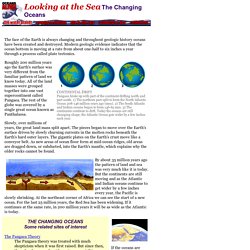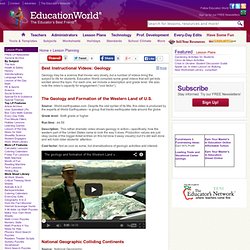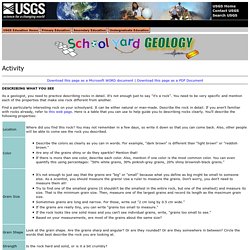

Geology - Rock Study
Welcome to the Science SOL 5.7 Earth Patterns, Cycles, and Change: Geology Pearltree. We linked all of our resources to the specific SOL strand that it covers. We focused on 5.7 a) Identification of rock types, and 5.7 b) The rock cycle and how transformations between rocks occur Earth Patterns, Cycles, and Change 5.7 The student will investigate and understand how Earth’s surface is constantly changing. Key concepts include: a) identification of rock types b) the rock cycle and how transformations between rocks occur c) Earth history and fossil evidence d) the basic structure of Earth’s interior e) changes in Earth’s crust due to plate tectonics f) weathering, erosion, and deposition g) human impact When you start your own Pearltree as a curation tool, you can choose from other Pearltrees that are related by subject! jennykathleenkarla
The Changing Oceans. The face of the Earth is always changing and throughout geologic history oceans have been created and destroyed.

Modern geologic evidence indicates that the ocean bottom is moving at a rate from about one-half to six inches a year through a process called plate tectonics. Roughly 200 million years ago the Earth's surface was very different from the familiar pattern of land we know today. All of the land masses were grouped together into one vast supercontinent called Pangaea. The rest of the globe was covered by a single great ocean known as Panthalassa. Slowly, over millions of years, the great land mass split apart. By about 35 million years ago the pattern of land and sea was very much like it is today.
Rock Formation. Rock Identification. Bill Nye The Science Guy & Rocks & Soil FULL EPISODE. 50 Really Cool Online Tools for Science Teachers. A 21st-century education revolves around the Internet for everything from collaboration, tools, lessons, and even earning degrees online.

If you are looking for ways to integrate online learning into your science class or science degree programs, then take a look at these cool online tools that are just perfect for both teachers and students. Science Tools to Use with Students These tools offer opportunities for learning about climate, cells, the human body, nature, and more. ChemiCool. Share this periodic table with your class for an easy to use tool with information on each of the specific elements.GPS Activities and Lesson Plans.
AP Tools Whether you are setting up a new AP curriculum or are just looking for additional material to use with your AP science students, these tools will help. Advanced Placement Biology. Websites and Resources for Science Teachers These websites are chock full of amazing resources and tools for science teachers. Discovery Education. Calculators Online Games. Crosscutting and Superposition. USGS Schoolyard Geology. Exploring Rocks and Minerals. Videos - Geology. Geology may be a science that moves very slowly, but a number of videos bring the subject to life for students.

Education World compiled some great videos that will get kids excited about the topic. For each one, we include a description and grade level. We also note the video’s capacity for engagement (“cool factor”). The Geology and Formation of the Western Land of U.S. Source: World-earthquakes.com. Grade level: Sixth grade or higher Run time: 44:59 Description: This rather dramatic video shows geology in action—specifically, how the western part of the United States came to look the way it does.
Cool factor: Not as cool as some, but dramatizations of geologic activities add interest. National Geographic Colliding Continents Source: National Geographic Grade level: All ages Run time: 50:05. Rocks for Kids - 15 Fun Activities and Ideas - Teach Junkie. StudyJams. Shake, Rattle and Slide. USGS Schoolyard Geology. The main purpose of this web site is to introduce teachers to the geologic features on their own schoolyard.

We hope to open their eyes to the possibilities for teaching geology to students in a familiar, easily accessible, and personally relevant setting. We have divided the site into three individual lessons: Teaching Sequence The lessons are completely independent but can work together as an effective sequence. The map exercises of Lesson 1 come first because teachers can refer to the schoolyard map throughout future exercises. During the mapping exercise, students will realize that there are geologic materials all over their schoolyard. Lesson 3 is a resource of example geologic features that might have analogs in the schoolyard. Schoolyard Geology Home • Lesson 1 • Lesson 2 • Lesson 3 • Downloads. USGS Schoolyard Geology. Download this page as a Microsoft WORD document | Download this page as a PDF Document As a geologist, you need to practice describing rocks in detail.

It's not enough just to say "it's a rock". You need to be very specific and mention each of the properties that make one rock different from another. Find a particularly interesting rock on your schoolyard. It can be either natural or man-made. Schoolyard Geology Home • Lesson 1 • Lesson 2 • Lesson 3 • Downloads. Geology Online Lesson Plans. The Magic School Bus. USGS Geology in the Parks. Mineral Resource of the Month. Videos - Geology. Dynamic Earth . Intro.
Human Impact.